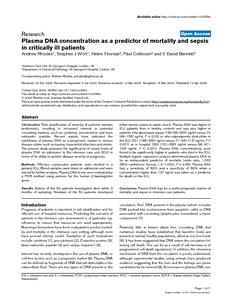Rhodes, A; Wort, SJ; Thomas, H; Collinson, P; Bennett, ED
(2006)
Plasma DNA concentration as a predictor of mortality and sepsis in critically ill patients.
CRITICAL CARE, 10 (2).
ISSN 1466-609X
https://doi.org/10.1186/cc4894
SGUL Authors: Collinson, Paul Bennett, Ephraim David Rhodes, Andrew
![[img]](https://openaccess.sgul.ac.uk/107192/1.hassmallThumbnailVersion/cc4894.pdf)  Preview |
|
["document_typename_application/pdf; charset=binary" not defined]
Published Version
Available under License St George's repository terms & conditions.
Download (262kB)
| Preview
|
Abstract
Introduction: Risk stratification of severely ill patients remains problematic, resulting in increased interest in potential circulating markers, such as cytokines, procalcitonin and brain natriuretic peptide. Recent reports have indicated the usefulness of plasma DNA as a prognostic marker in various disease states such as trauma, myocardial infarction and stroke. The present study assesses the significance of raised levels of plasma DNA on admission to the intensive care unit (ICU) in terms of its ability to predict disease severity or prognosis.
Methods: Fifty-two consecutive patients were studied in a general ICU. Blood samples were taken on admission and were stored for further analysis. Plasma DNA levels were estimated by a PCR method using primers for the human β-haemoglobin gene.
Results: Sixteen of the 52 patients investigated died within 3 months of sampling. Nineteen of the 52 patients developed either severe sepsis or septic shock. Plasma DNA was higher in ICU patients than in healthy controls and was also higher in patients who developed sepsis (192 (65–362) ng/ml versus 74 (46–156) ng/ml, P = 0.03) or who subsequently died either in the ICU (321 (185–430) ng/ml versus 71 (46–113) ng/ml, P < 0.001) or in hospital (260 (151–380) ng/ml versus 68 (47–103) ng/ml, P < 0.001). Plasma DNA concentrations were found to be significantly higher in patients who died in the ICU. Multiple logistic regression analysis determined plasma DNA to be an independent predictor of mortality (odds ratio, 1.002 (95% confidence interval, 1.0–1.004), P = 0.05). Plasma DNA had a sensitivity of 92% and a specificity of 80% when a concentration higher than 127 ng/ml was taken as a predictor for death on the ICU.
Conclusion: Plasma DNA may be a useful prognostic marker of mortality and sepsis in intensive care patients.
| Item Type: |
Article
|
| Additional Information: |
© 2006 Rhodes et al., licensee BioMed Central Ltd.
This is an open access article distributed under the terms of the Creative Commons Attribution License (http://creativecommons.org/licenses/by/2.0), which permits unrestricted use, distribution, and reproduction in any medium, provided the original work is properly cited. |
| Keywords: |
Adult, Aged, Aged, 80 and over, Biological Markers, Critical Illness, DNA, Female, Hospital Mortality, Humans, Intensive Care Units, Male, Middle Aged, Predictive Value of Tests, Prospective Studies, Sepsis, Science & Technology, Life Sciences & Biomedicine, Critical Care Medicine, General & Internal Medicine, CRITICAL CARE MEDICINE, CELL-FREE DNA, PROGNOSTIC MARKER, CIRCULATING DNA, CANCER-PATIENTS, ORGAN FAILURE, ORIGIN, ACID, 11 Medical And Health Sciences |
| Journal or Publication Title: |
CRITICAL CARE |
| ISSN: |
1466-609X |
| Related URLs: |
|
| Web of Science ID: |
WOS:000240436400021 |
| Dates: |
| Date |
Event |
| 2006-04-13 |
Published |
|
| URI: |
https://openaccess.sgul.ac.uk/id/eprint/107192 |
| Publisher's version: |
https://doi.org/10.1186/cc4894 |
Statistics
Item downloaded times since 24 Sep 2014.
Actions (login required)
 |
Edit Item |


